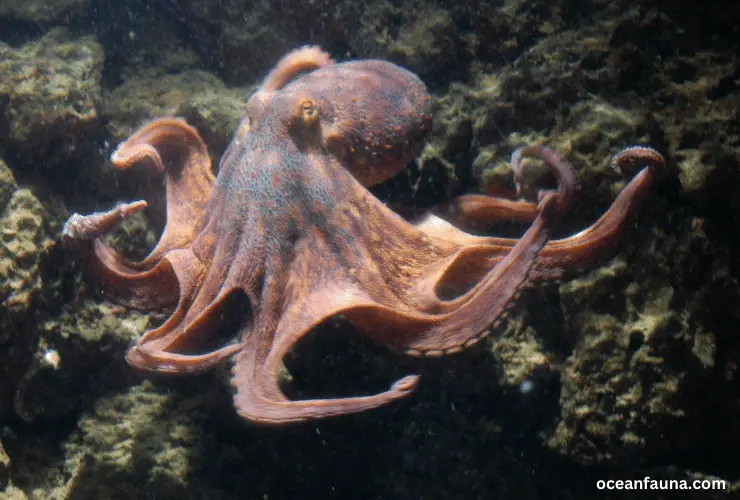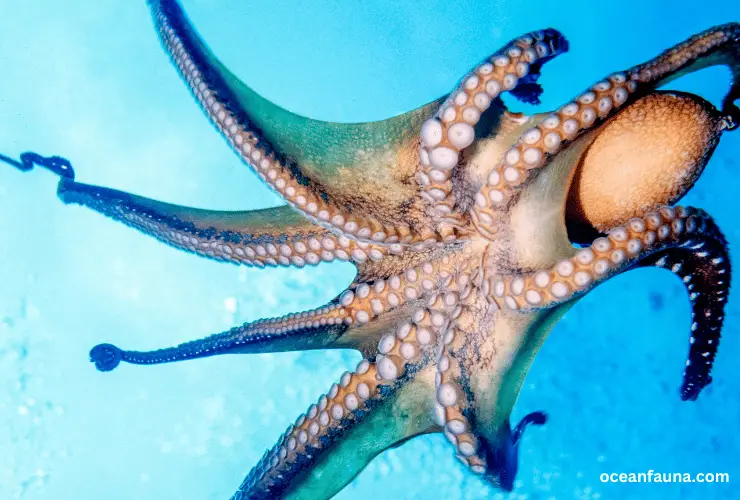Octopuses are fast swimmers who have to survive the competitive sea environment. Moreover, they can swim up to 25 miles per hour. Their fast movement and very flexible body help them hunt food and escape the predator’s view.
Moreover, they have about 300 suckers and millions of sense receptors so that they can feel the texture and taste of their prey.
Now coming to their swimming skills which is a necessity for them. They have high motor skills meaning motion and movement. Their complicated movement also includes walking, crawling and climbing.
They swim through the water by flailing their arms, and they avoid danger by shooting a powerful stream of water, sometimes laced with ink from a siphon.
Now let’s get into more details about how fast octopuses can swim. So if you want to know the details walk with us through this article.
How Do Octopuses Move?
The octopus has two modes of movement. Octopuses use their arms to feel into holes in the seafloor for food as they crawl through the bottom of the ocean in quest of it. The octopus’s cup-shaped suckers on its arms help it maintain a firm grasp as it moves.
However, a scared octopus does not retreat in a relaxed manner. Instead, it swims rapidly away, forming a torpedo shape to cut through the water. The octopus accomplishes this by shooting water from the sacs on its body.
It takes in water through a mouth and spits it out through a snout-like tube underneath its head. This allows the octopus to swim in reverse through the water, propelled by the power of the water being squirted out. This mode of propulsion is known as jet propulsion.
How Fast Can an Octopus Swim?
Compared to other ocean animals, octopuses are fast swimmers. They move forward by expelling water through their mantles.
But from their movement, you can’t say they can swim fast. However, to your surprise, these mysterious sea creatures can swim 25 miles per hour.
To move fast from one place to another, they use a mechanism called jet propulsion. This mechanism is seen in other cephalopods like squid.
One important body part that helps a lot in their movement is the Siphon. Basically, octopuses will suck the water into the muscular sacs and then expel it through the siphon. The faster the octopus swims, the more force is applied to the water as it exits the siphon.
How Is Hunting Affected by Octopus’s Movement?
In brief underwater sprints, octopuses have been clocked at speeds of up to 25 miles per hour. These velocities are often reserved for times of extreme peril or when closing the gap on fleeing prey.
They are able to travel at such a high pace because they channel water to form miniature jet streams. Although it is capable of such speeds, the Giant Pacific Octopus typically hunts by sneaking up on its prey.
By changing their skin tone and pattern, they can hide in plain sight. This serves two purposes: it keeps them safe from danger, and it allows them to wait in ambush for their victim. It’s like when you’re hungry and waiting for the pizza delivery person to arrive.
The Giant Pacific Octopus has a row of suckers along the inside of each arm. One can safely hang up to 35 pounds from each individual sucker.

This means that the odds of survival for an animal that happens to enter the path of a Giant Pacific Octopus are rather low.
These octopuses frequently employ the web of skin that links their arms as a “trap” similar to a canopy. They can suffocate their prey in a blanket of death.
The animal uses its limbs as legs, allowing it to walk or crawl around the ocean floor when it wants to change its location.
Conclusion
Till now, it’s pretty visible that octopuses are fast swimmers, as they are able to swim 25 miles per hour.
However, their swimming speeds depend either on catching food or predator attacks. For example, if they need to catch the food, they’ll move slowly. But if any predator attacks them, they’ll escape the place as soon as possible.
The octopus has multiple levels of motor control, including the central nervous system, each limb, and even each individual sucker. Because of this, octopuses may be very flexible and adaptable, which aids in problem-solving.


3 thoughts on “How Fast Can an Octopus Swim?”